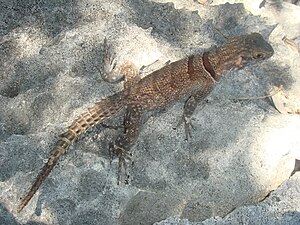Madagascar spiny-tailed iguana
This article was based on formal or substantive deficiencies in the quality assurance biology in the section "Reptiles" entered for improvement. This is done in order to bring the quality of the biology articles to an acceptable level. Please help improve this article! Articles that are not significantly improved can be deleted if necessary.
Read the more detailed information in the minimum requirements for biology articles .
| Madagascar spiny-tailed iguana | ||||||||||||
|---|---|---|---|---|---|---|---|---|---|---|---|---|

Madagascar spiny-tailed iguana ( Oplurus cyclurus ) |
||||||||||||
| Systematics | ||||||||||||
|
||||||||||||
| Scientific name | ||||||||||||
| Oplurus cyclurus | ||||||||||||
| ( Merrem , 1820) |
The Madagascar barbed iguana ( Oplurus cyclurus ), also known as the small Madagascar tree iguana , belongs to the genus Oplurus within the family of Madagascar iguanas (Opluridae) .
description
The Madagascar spiny-tailed iguana reaches a total length of 25 cm. The color of the body varies between brown and gray and is streaked with dark bands. The skin appears wrinkled in the neck area. It has strong extremities that end in powerful and long claws.
distribution and habitat
Oplurus cyclurus is endemic to Madagascar and occurs there in the south-west, south-east and north-west, in the south-west this Madagascar iguana is most common. It lives in arid areas and is a mostly tree-dwelling species in dry deciduous forests and thorn tree savannas. The frequency appears to be associated with the presence of termite mounds and fallen logs. Possibly due to the lack of termite mounds and tree trunks, the species is absent in cleared areas. Oplurus cyclurus occurs at heights of 15 to 240 meters.
attitude
A couple with a body-trunk length of 25 cm needs a terrarium with the minimum dimensions 100 × 50 × 80 cm (L × W × H). In larger terrariums, groups can also be kept, with 2–4 females per male. Since the animals like to climb well and well, structuring the terrarium with a back wall and climbing branches is important for natural behavior. The humidity should be 70% and the daytime temperature 25–28 ° C, whereby the warming area can be up to 40 ° C. Lowering the air temperature to 22 ° C at night is particularly important for the animals' well-being.
Individual evidence
- ↑ Uwe Schlüter: Madagascar iguanas - way of life, care and reproduction . - KUS-Verlag, Rheinstetten, 2013. ISBN 978-3-9808264-8-8 .
- ↑ IUCN
Web links
- Oplurus cyclurus inthe IUCN 2013 Red List of Threatened Species . Posted by: Vences, M., 2011. Retrieved January 30, 2014.
- Oplurus cyclurus in The Reptile Database